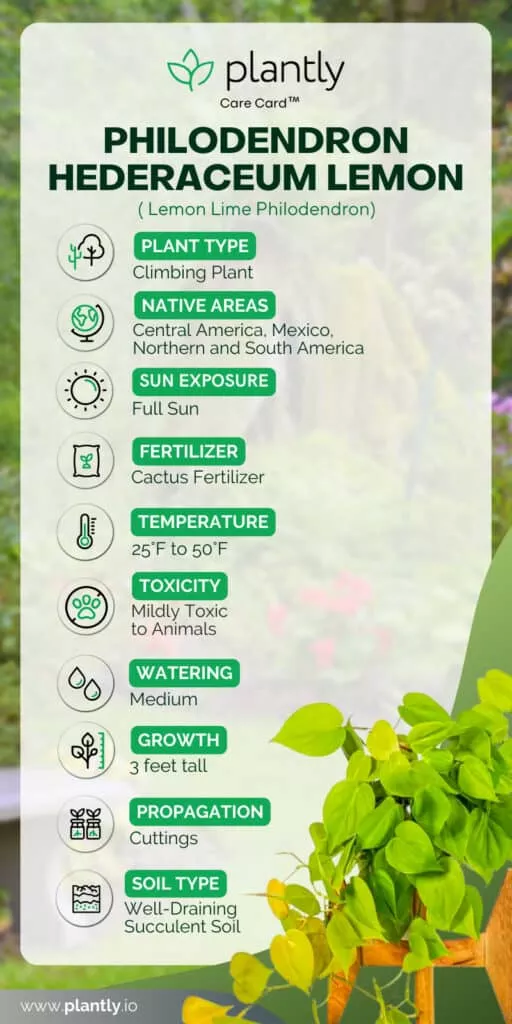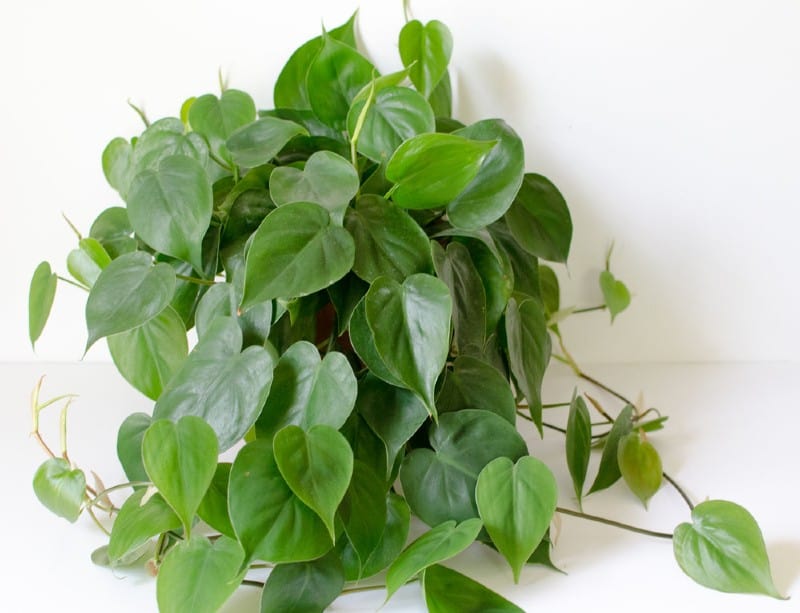No products in the cart.
Table of Contents
The Philodendron plants are all-time favorites for indoor and outdoor gardens. These plants increase and adapt quickly to household conditions. As a result, they show steady growth and remain popular worldwide.
So, if you want an indoor plant that is straightforward to care for, the Philodendron hederaceum is a great plant to have. The climbing plant has gorgeous heart-shaped leaves, but it can also be a self-heading plant on its own.
What is Philodendron Hederaceum?
The Philodendron hederaceum has conquered many houseplant enthusiasts’ hearts. The heartleaf philodendron plants have the most fabulous glossy heart-shaped leaves.
It looks good no matter where you place this tropical plant without anything on a table. Instead, you can set the climber in a regular pot, train it with a moss pole, or put it in a hanging basket. The evergreen perennial grows in its natural habitat in Central and South America.
You can find the heartleaf philodendron in parts of the Caribbean tropical rainforests. So, your plant needs loads of humidity and light. Still, it remains a hardy plant and fits in perfectly to an indoor environment.
Once new leaves grow, it has a bronze color but turns to a vibrant green as it matures. Yes, what makes this plant spectacular is the leaves shaped like hearts.

Heartleaf Philodendron Care

Suppose you are in a hurry and need the short and sweet of caring for your indoor plants. Then your heart leaf philodendron vine needs sphagnum peat moss-based potting soil.
Of course, it needs moist air, soil moisture, some bright light, and loads of tender loving care. Still, we recommend reading the informed details here on how to care for your heartleaf philodendron plants.
Best Soil Mixture for Heartleaf Philodendron
Your plant is not picky when it comes to potting soil. Yet, we do recommend when the time comes to re-pot provide it with fresh potting soil like peat moss.
The important thing is it needs well-draining, moist soil to prevent root rot. As long as the soil remains airy and well-drained, your plant’s roots will be happy.
If you feel the soils are too compact, you can add some perlite or pumice to the mix.
Lighting Needs of Heartleaf Philodendron Plants

Your heartleaf philodendron can grow in moderate to bright indirect light. So, find a damp and sunny spot for those gorgeous leaves to grow. Even in winter, when it comes to heartleaf philodendron care, you will not have problems with light. Your indoor plant does pretty well in low light as well.
Watering Condition To Prevent Root Rot
Compared to other plants in the Philodendron genus, the heartleaf philodendron does not need much water. Thus, we recommend leaving your leafy friends’ soil slightly moist and dry out between watering.
So, how often should you water your indoor plant? It depends on the environment. The best is to check the soil to see if the top inch is dry before watering. Then, give your plant deep watering over the sink allowing the excess water flows through the drainage hole.
Doing this prevents waterlogged soil. Another helpful thing is to provide your plant with rainwater if possible, or you can use distilled water. Still, if you have no choice, you can leave some tap water standing for 24 hours before using it.
Optimal Temperature and Humidity Level

Your plant loves average room temperature between 62°F to 75°F (16 to 24°C). It will feel right at home. Still, if you grow your heartleaf philodendron as an outdoor plant, we recommend bringing it inside. Your heartleaf does not appreciate temperatures below 62°F.
Furthermore, your plant also prefers a 60% and above humidity level. If you live in a drier climate you can provide your plant with moisture in a bathroom as it can tolerate low light. Even grouping plants helps to provide the moisture with your heartleaf philodendron needs.
Feeding your Tropical Plant
Another fantastic thing about your heartleaf philodendron grown indoors is that it is not a big feeder. You can feed your leafy friend once a month in winter with a balanced, slow-release fertilizer. You can give it a light feed every four weeks during the growing season.
Growth, Re-Potting, and Pruning
The climbing heartleaf philodendron can reach up to 20 feet tall. Still, when it comes to indoor gardening, it only reaches 10 feet tall. Hence, it helps to provide your plant with a moss pole.
The trailing plant only produces flowers for reproduction and displays up to three blooms remaining open for a few days. When this happens, your plant produces a spathe in a green shade and has an oval shape.
Inside the spathe, you see a white spadix with fertile male and female flowers. Your plant also needs light pruning. You can pinch back stems to prevent leggy growth. This helps the Philodendron leaves grow as a bushy plant to make them look fuller.
The best time to do this is during the actively growing season in the warm months. The best is to make a clean cut after the node using clean scissors or your fingers. Another impressive thing with your green friend is you only need to re-pot every couple of years.
We recommend using containers with enough drainage holes. It is a great time to provide them with a fresh potting mix. The best time to do this is in the active growing season in spring and early summer.
Propagate Heartleaf Philodendron
The fantastic thing is with stem cuttings from the leaf node tips. Then, you can propagate your leaf Philodendron plants to gift to family and friends. The important thing is that your plant needs to be in good health. Here is a step-by-step guide to help you get started.
First, wash your hands and prepare a sterilized pot with some potting soil mix. Next, dampen the soil.
Take a chopstick or anything similar to poke holes in the soil to plant your stem cuttings.
Take a healthy stem tip cutting of up to 3 inches long using a sterile knife below the leaf node.
Leave the topmost leaves and remove the bottom half and dip that end into water and some rooting hormone.
Poke the stem tip in the hole and close up the soil.
Place a plastic bag over the container to form a moisture chamber but do not seal completely to allow airflow around your cuttings.
Mist the cuttings daily in the morning and keep the soil moist but not soggy. Keep your plant in a plastic bag for two weeks.
After two weeks, remove the bag and look to see if your cutting has rooted. If rooted, you can transplant the cuttings into individual pots.
Philodendron Varieties
You can find dozens of Philodendron species you can keep with your heartleaf philodendron. You find variegated forms with cream stripes to elongated leaves with a silver or cream splash. Here are some great indoor plants you can grow indoors.
Philodendron bipinnatifidum
The cut-leaf philodendron is a herbaceous plant with thick stems and large glossy brownish-green leaves. You notice a lime-green venation, and it grows well in bright indirect light. You can grow it outdoors in partial to full shade but not in direct sunlight that will burn the leaves.
Philodendron erubescens
The blushing philodendron has trailing vines with green leaves, while the underside is reddish.
Philodendron hybrids
The bird’s nest philodendron is a plant with spade-shaped leaves in various colors grows from a bushy base, and is non-climbing.
Heartleaf Philodendron Disease and Pests
Pests are not a tremendous problem for the heartleaf philodendron plants compared to root rot. Your common insects found on this sweetheart plant are spider mites, fungus gnats, scale insects, and mealybugs.
The main problem is root rot from overwatering, which threatens your green companion. You will notice that the roots turn brown and form yellow leaves, and you see wilting leaves. Remove the infected soil by adding clean potting soil to save your plant.
You can also keep the healthy portions and discard the diseased parts. Or take a stem cutting from the healthy leaves to propagate.
Frequently Asked Questions
Philodendrons have a tropical nature and can thrive in indoor climates and grow well as an outdoor plant in a shady spot. When you grow heartleaf philodendron outside, it helps flush the soil and clean the leaves.
You can pinch the vine tips using your fingernails or pruning shears for a bushier plant. It helps to neaten up your Philodendron scandens and boosts bushier growth. You can do this by cutting above the leaf node that is the point of the stem.
Your heartleaf philodendron plants have aerial roots and need trellis-like most poles to provide them with damp support to attach their roots.
You can find the Philodendron scandens sold at your local garden center. Or you can browse through the Plantly collection here to buy your heartleaf philodendron plants. The best part is you can have your plant delivered to your door.
Whether you want to buy, sell or simply reach out to other plant enthusiasts, Plantly is the right place to be!


